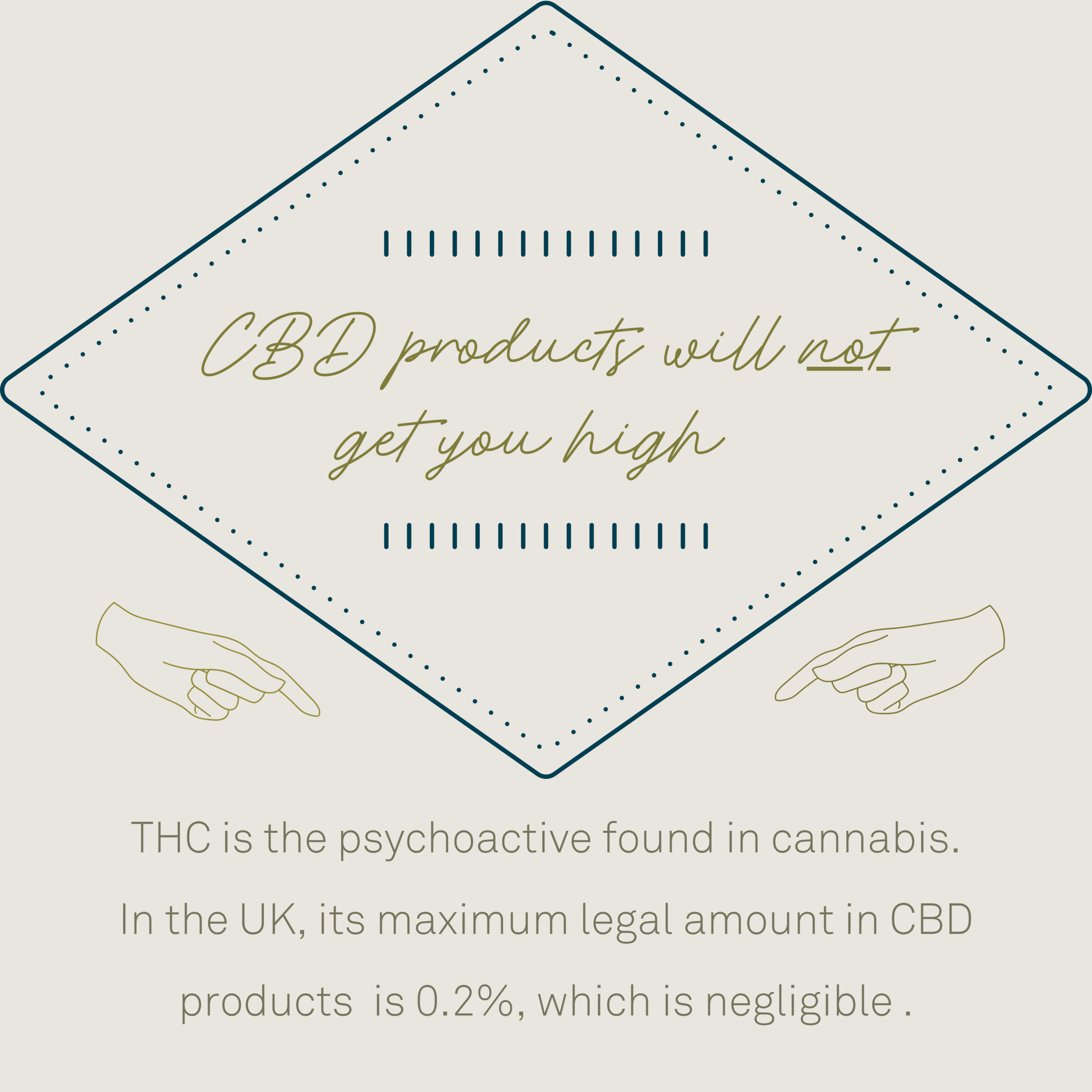All your questions about CBD, answered
In this running post, we answer all your questions about CBD. If you have any questions we haven’t answered yet, let us know in the comments.
Important: the contents of this article do not make any CBD health claims. Speak to your physician before consuming any foods supplements.
CBD F.A.Q.
1. What is CBD?
CBD is Cannabidiol, the most abundant non-psychoactive compound found in the Cannabis Sativa (Hemp)plant. The effectiveness of CBD has not yet been scientifically proven, but it is a hugely popular product for a range of wellness issues.
2. How much THC is in CBD products?
THC (Tetrahydrocannabidol) is a psychoactive compound found in cannabis, responsible for mood changing effects (euphoria and sedation). The legal amount of THC in CBD products in the UK is 0.2%, which is negligible. (1) (2)
3. Is CBD oil same as Hemp oil?
No. Hemp oil comes from the seeds of the Cannabis plant, and does not contain significant amounts of CBD. CBD oil mainly comes from the leaves of the plant.
4. What are the different ways CBD is made?
CBD can be extracted with carbon dioxide (CO2) or by steam distillation, with or without solvents (3).
CO2 extraction is made at low temperature, which allows high amounts of CBD to remain in the oil. It is a very common extraction method.
Steam Distillation works by separating the CBD oil from the hemp plant during vaporization. This method is successfully used in majority of essential oils production, but it requires larger amounts of the hemp plant and doesn’t allow for the same precision in the dosage of CBD.
Solvent Extraction follows similar steps to Distillation but is made with a solvent instead of water. Solvents can be natural, such as olive oil or ethanol, or synthetic (hydrocarbons), such as petroleum, butane etc. which can be toxic for the body. Natural solvents, however have the downside of lso releasing chlorophyll which can give the product a stronger taste and color.
5. What are different ways to consume CBD?
CBD products are extremely popular and may come in the form of oil (tincture), spray, tablets, softgel capsules, vape, balm, topical oil, ointment, cream and more.
Oral liquid form
The most popular way of using CBD is in oral liquid form, such as oil tincture or spray. Generally speaking, liquids tend to absorb faster through our oral mucosa than capsules or tablets, which need to pass through GI tract.
If you want to take CBD as an occasional remedy or to help to support and acute event, this might be your preferred form, due to the rapid absorption ( 20- 30mins). That being said, absorption and effectiveness of CBD might vary widely from one individual to another and may be influenced by numerous factors. Moreover, research on CBD is still in its infancy, so there is no established recommended dosage or intake.
Capsules
Capsules can be a great option for those who don’t like the taste of CBD or who want to support a chronic issue. They may take a little bit longer to get into the system comparing to liquids, but tend to stay in the body for longer, thus fewer doses may be needed throughout the day.
Topical CBD
Topical CBD products, such as face creams, balms and massage oils are popular among those who want to support specific area in the body. CBD is anecdotally found to possess an anti-spasmatic and anti-inflammatory effect. Some find that massage oils can be helpful to relieve aching muscles and support total relaxation of the body, while face creams can be considered to soothe dry, flaky, or irritated skin.
6. What should I look for when buying a CBD product?
CBD is very popular and you can find an ever-growing offering of products and brands on the market. Prices do vary significantly as they reflect the quality, the extraction method and the strength of the product. Always question: can I trust the company? Where is the product made? What type of extraction does the company use? How much of the actual CBD is the product?
The quality of the product and the right dosage of CBD are the two most important factors when deciding which product to go for. Preferably, choose CO2 extracted, full/broad spectrum CBD.
7. Where to start with CBD?
First, always look for a good quality product, consider the points mentioned earlier when choosing between the options on the market.
Furthermore, as previously mentioned, there is no established recommended dose for any specific health issue, age group etc. Therefore, it is recommended to start with a lower dose and, if needed, to gently build up to a higher dosage.
If you are trying a CBD product for the first time, most people start with few drops of 5-10% dilution CBD oil, which, on average, provides between 2.5 to 5mg of CBD per drop. From there, they build up the dose slowly if needed.
8. How does CBD work in the body?
We naturally have endocannabinoid system in our bodies, with two main endocannabinoid receptors CB1 and CB2. CB1 are highly expressed on neurons in the nervous system, and modulate neurotransmitters release, while CB2 are primarily expressed on immune cells (11),
CBD indirectly acts as an endogenous cannabinoid receptor agonist to exerts its neuroprotective and immunomodulating effects (12)(13)(14).
Moreover, CBD has been shown to interact with diverse molecular targets, and cannabidiol receptors are just some of them (15). According to recent research, the endocannabinoid system plays an important role in reproductive, immune and central nervous systems, gastrointestinal processes, inflammation and pain (4)(5)(6)(7)(8).
9. What is the difference between “Full spectrum” and “Isolate”?
CBD can come in isolate or full spectrum form. Isolate focuses on CBD only, and thus extracted from the plant as single compound to use in the products. However, the Cannabis plant contains more than just CBD. It is also rich in other cannabinoids which also seem to be beneficial , such as Canabichromene (CBC), Canabigerol (CBG) and many others (9). It also contains antioxidants, terpenes, and flavonoids. Using CBD with all these other components could potentially be more beneficial due to synergestic effect between these phytochemicals , often called “entourage effect” (10).
The product containing of all these other compounds rather than just CBD is called Full/Broad spectrum CBD.
10. What are the most common uses for CBD?
People use CBD for various reasons, starting with general health and including sleeping issues, anxiety, stress, sudden or chronic pain and inflammation of the joints, muscles or other tissues. As we already mentioned, no one can make any health claims about CBD, as it is not yet fully understood how exactly CBD works in the body and there are not many clinical trials done.
However, some very recent research points to a potential anti-inflammatory effect on the joints, and may be promising future treatment in patients with RA and osteoarthritis (16)(17). A 2016 topical CBD study showed it had positive effect on pain relief and inflammation in arthritis (18). Another 2018 study revealed a potential analgesic and anti-inflammatory effect on headache, migraine, chronic pain and arthritis (19). A systematic review (2020) on articles published between 2000 and 2019, with 25 studies in human trials revealed promising CBD results on anxiety and psychotic disorder (20).
Disclaimer: The contents of this article do not make any CBD health claims and are not intended to diagnose or treat any health conditions. Speak to your physician before consuming any food supplements or CBD products.
Sources
1. MedicPro [online] CBD Regulation and Laws in the UK. Available at; https://www.medicpro.london/cbd-regulation-laws-uk/
2. Gov.UK [online] Home Office. Low THC Cannabis (industrial Hemp) Licensing Fact Sheet. Available at; https://www.medicpro.london/cbd- regulation-laws-uk/
3. CBD Awarness Project [online] How are CBD Products Made? Available at; https://www.cbdoil.org/cbd-extraction-methods/
4. Di Marzo V. and Piscitelli F. The Endocannabinoid System and its Modulation by Phytocannabinoids. Neurotherapeutics. 2015 Oct;12(4):692-8.
5. Maia J. et al. The fundamental role of the endocannabinoid system in endometrium and placenta: implications in pathophysiological aspects of uterine and pregnancy disorders. Hum Reprod Update. 2020 Apr 29.
6. Hu SS. and Mackie K. Distribution of the Endocannabinoid System in the Central Nervous System. Handb Exp Pharmacol. 2015;231:59-93.
7. Gotfried J. et al. Role of Cannabis and Its Derivatives in Gastrointestinal and Hepatic Disease. Gastroenterology. 2020 Apr 22.
8. Frede c.et al. Sensitivity of the Fasciae to the Endocannabinoid System: Production of Hyaluronan-Rich Vesicles and Potential Peripheral Effects of Cannabinoids in Fascial Tissue. Int J Mol Sci. 2020 Apr 22;21(8).
9. Elsohly MA. El al. Phytochemistry of Cannabis sativa L. Prog Chem Org Nat Prod. 2017;103:1-36.
10. Smeriglio A. et al. Promising in vitro antioxidant, anti- acetylcholinesterase and neuroactive effects of essential oil from two non-psychotropic Cannabis sativa L. biotypes. Phytother Res. 2020 Apr 20.
11. Schurman LD. et al. Molecular Mechanism and Cannabinoid Pharmacology. Handb Exp Pharmacol. 2020 Apr 1.
12. Li H. et al. Overview of cannabidiol (CBD) and its analogues: Structures, biological activities, and neuroprotective mechanisms in epilepsy and Alzheimer's disease.
13. Dinu AR.et al. Cannabis Sativa Revisited-Crosstalk between microRNA Expression, Inflammation, Oxidative Stress, and Endocannabinoid Response System in Critically Ill Patients with Sepsis. Cells. 2020 Jan 28;9(2).
14. Winklmayer M. et al. Dose-Dependent Cannabidiol-Induced Elevation of Intracellular Calcium and Apoptosis in Human Articular Chondrocytes. J Orthop Res. 2019 Dec;37(12):2540-2549.
15. Alves P. et al. Cannabis sativa: much more beyond Δ9- tetrahydrocannabinol. Pharmacol Res. 2020 Apr 23:104822.
16. Lowin T. et al. Joints for joints: cannabinoids in the treatment of rheumatoid arthritis. Curr Opin Rheumatol. 2019 May;31(3):271-278.
17. Fitzcharles MA. et al. A cautious hope for cannabidiol (CBD) in rheumatology care. Arthritis Care Res (Hoboken). 2020 Mar 7.
18. Hammell DC. Et al. Transdermal cannabidiol reduces inflammation and pain-related behaviours in a rat model of arthritis. Eur J Pain. 2016 Jul;20(6):936-48.
19. Baron EP. Et al. Patterns of medicinal cannabis use, strain analysis, and substitution effect among patients with migraine, headache, arthritis, and chronic pain in a medicinal cannabis cohort. J Headache Pain. 2018 May 24;19(1):37.
20. Larsen C. and Shahinas J. Dosage, Efficacy and Safety of Cannabidiol Administration in Adults: A Systematic Review of Human Trials. J Clin Med Res. 2020 Mar;12(3):129-141.





